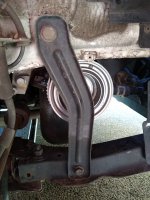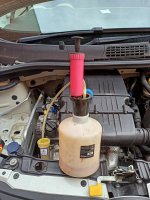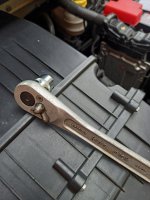PS to the above. This thing about a "Phonic Wheel Relearn" really quite frightened me when I did my first one as I didn't really know what it was or how to do it.
It only applies to engines which have a crankshaft and camshaft sensor - so that's effectively most of the cars, with 8 valve FIRE engines currently running around. Our old 1992 999cc Panda Parade didn't have the cam sensor so didn't require this procedure but our 2010 Panda 1.2 (60Hp) and my boy's 2012 1.4 Punto (with VVT) both have the sensors.
Because I didn't understand what this was all about, but knew that I needed
Multiecuscan (
MES) to do it, I bought a licensed copy from Gendan and I've never regretted it.
On the other hand, being a retired motor mechanic (definitely old school) I had a very good understanding of what cam timing is all about and many related aspects - I've built up a small number of high performance engines where accurate cam timing was achieved by the use of offset keys. I've always been a keen advocate of letting "sleeping dogs" lie, so I wondered if you really need to undo the cam sprocket securing bolt. I did a lot of research and reading up on what it's all about and then related this to the older engines I'd worked on. Older engines commonly have both the crankshaft and camshaft sprockets keyed or doweled to their shafts so timing up is very simple, just line the marks up and fit the belt (or chain). The timing will be roughly right but checking if it's spot on is difficult and trying to adjust to get it spot on is even more difficult (and probably of minimal benefit to these older engines)
Now a days though, super accurate cam timing (and ignition) is needed to give minimal emissions and good fuel consumption (other "stuff" too) So the manufacturers make their engines so this cam/crank phasing (timing) can be set very accurately. They achieve this on our FIRE engines by omitting the cam sprocket dowel/key which allows the cam sprocket to rotate freely on the end of the camshaft once it's retaining bolt is slackened. This allows the crankshaft and camshaft to be locked in perfect relation to one another using the locking tools and the belt mounted on the sprockets and tensioned WITH THE CAM SPROCKET BOLT STILL SLACK (by the way it only needs to be half a turn slack at most - if the sprocket can turn freely on the end of the camshaft that'll do nicely.) When you now tighten the cam sprocket bolt this locks cam and crank in their correct timed positions in relation to each other. (By the way, on VVT engines this locking bolt is behind the blanking plug on the front face of the pulley which is full of oil so a nice big rag is needed when you remove the plug!)
What I was thinking was "That cam bolt is reputed to be very tight and anyway I'd really rather let this "dog" lie if possible. Surely, as long as you buy a quality product, the cam belts are microscopically accurately made? so, as long as you refit the new belt in exactly the same relationship as the old one all will be well? So I set out to explore this. I bought the timing tools and set the engine up with the crank locking tool installed then tried the cam locking tool and it slid perfectly into place. This confirms that the timing is correct (which didn't surprise me as I'm about 95% certain it was it's first change - overdue at some 60.000 miles and around 8 years !).
Then I tippex marked the old belt and sprockets before removing it. Transferred the marks, very carefully, to the new belt and fitted it to the engine, removed the timing tools and tensioned the tensioner. Turned the engine through two revs very slowly and carefully. Lined up and installed the crank locking tool and tried the cam locking tool, It slid into place as nice as you please thus confirming the timing to be correct. I repeated the exercise on my boy's Punto 1,4 (with VVT sprocket. my Panda has a solid sprocket) and the outcome was the same. The Punto was much lower mileage, only 40 something thousand so definitely it's first change (the relevance of that being that with both cars the timing was last set up at the factory, so surely correct.) Now I know this may be controversial, but, the conclusion I reached as a result is that, as long as the timing is correct before you start, you do not need to slacken the cam sprocket bolt. Of course you must buy/borrow the tools to check this but if you are going to keep the car long term, as we do, on subsequent belt changes you can do the change using tippex marks alone confident your timing will be correct (makes it much quicker as you don't need to remove the cam cover). If the cam timing tool can't be inserted after locking up the crank then you will have to slacken the cam sprocket bolt and do the while bit with the timing tools.
So what's all this about Phonic Wheels? I hear you muttering. The phonic wheel in question here is the segmented pulley on the crankshaft which the crank sensor uses to monitor crankshaft angular displacement and send it's signals to the ECU. The cam sensor is also sending a signal to this ECU and the ECU knows that it should recieve a signal from the cam at a certain angular displacement of the crankshaft. It uses these signals to calculate which plugs to fire and exactly when to fire them. If the cam sprocket bolt has been tightened when the camshaft is not exactly in the right place as dictated by the timing tools then the ECU will receive a signal from the cam sensor at a crankshaft angle it's not expecting and, after a wee while, it'll light up the check engine light and post a Diagnostic Trouble Code (DTC) which you can read out with your
MES. Unfortunately the ECU often doesn't recognize something is amiss until you are bowling along at a good speed - dual carriageway/motorway - so you don't relate it to a cam timing problem and when you interrogate for the code people on here have reported it's not unusual to find it comes up as a miss fire code which has, in the past, sent people off on an expensive trail replacing HT leads, coil packs, spark plugs etc without getting rid of the code. The difference in angle only needs to be very small and I have a bit of a theory that simply the action of slackening that sprocket bolt and retightening it can introduce enough angular displacement between the cam sprocket and the camshaft itself to "upset" the ECU. The answer of course is to perform a Phonic Wheel Relearn and
MES leads you by the nose through the process. Neither of our cars has flashed up a code or needed reset despite not slackening the cam sprocket bolt. However it's very useful to be aware that if you've recently done a cam belt and shortly afterwards, maybe after some running at sustained higher engine rpm, the CEL lights up it's an odds on bet you need to do a phonic wheel relearn - especially if the cam sprocket bolt was slackened and retightened during the process.
Having said all that, I'm in the fortunate position of having quite an in depth understanding of what's going on with all this. If you are unsure you are much much safer to simply follow the manufacturer's instructions and use the timing tools appropriately.
I'm now getting a bit "lost" in my own confused thoughts so I'm going to stop here - but I'd love for others to comment and perhaps tear me, and my ideas, to pieces. However I will say in my defence that all the small garages - except one - that I know do these belts by the tippex method and report never having CELs lit or having to do relearns.





